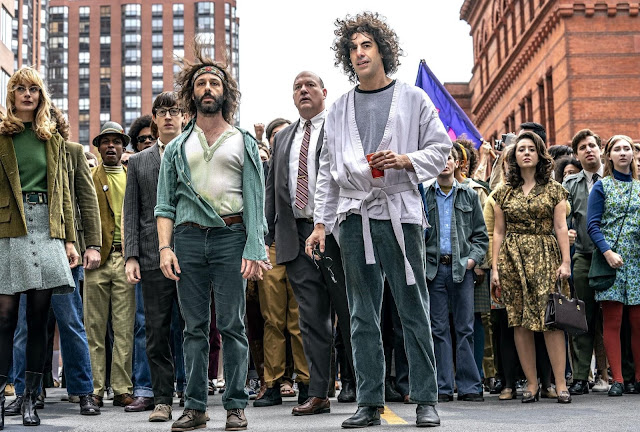‘Mank’ is a great movie about the greatest movie ever made
By Tom Siebert
“You’re asking a lot of a motion picture audience,” John Houseman tells screenwriter Herman Mankiewicz in the verbally and visually elegant film “Mank,” now streaming on Netflix and nominated for a leading ten Academy Awards.
Houseman, best known for “The Paper Chase” movie and television series, was referring to Mankiewicz’ Oscar-winning screenplay for 1941’s “Citizen Kane,” which is regarded by most film critics as the best cinematic feat of the past 80 years.
But the legendary actor/producer could have been referring futuristically to “Mank,” which almost requires advanced degrees in film, U.S. history, and Hollywood lore to fully “get.”
For instance, you kind of have to know that Orson Welles was a 23-year-old radio director who narrated a historic adaption of H.G. Wells’ science fiction book, “War of the Worlds,” in 1938.
The “breaking news” nationwide broadcast was so realistic that thousands of panicked listeners lit up telephone switchboards at CBS affiliates across the country, asking if Martians had really landed in New Jersey and attacked nearby New York City.
The scary you-are-there authenticity of “War of the Worlds” prompted RKO Pictures to give the wunderkind Welles carte blanche to write, direct, and produce a major film, which would become “Citizen Kane,” the Big Bang of moviemaking.
To write the script, Welles hired alcoholic, cynical wordsmith Mankiewicz, who once sent a telegram to his former newspaper colleague Ben Hecht (“The Front Page") inviting him to Tinseltown.
“Millions are to be grabbed out here and your only competition is idiots,” he wrote.
“Mank” has the screenwriter sending the infamous missive to director Charles Lederer (“His Girl Friday") but never mind, this is Hollywood.
In another instance of “Mank” playing fast and loose with film facts, movie mogul Louis B. Mayer is shown telling his writers: “I’m not interested in educating our customers. You want to send a message? Call Western Union.” The paraphrased quote is most often attributed to fellow studio head Samuel Goldwyn.
It’s almost as if “Mank” director David Fincher (“The Curious Case of Benjamin Button,” “Gone Girl”) wanted to slightly fictionalize his Old Hollywood story to maintain plausible legal deniability, in the same way that “Citizen Kane” is a flimsily disguised assault on media magnate William Randolph Hearst, who at one time owned 28 newspapers in major American cities.
No one really knows why Welles chose Hearst as the inspiration for his first and most famous film, but “Mank” would have us believe that it was Mankiewicz, a bleeding-heart progressive, who was writing out his resentments against the newspaper titan, an ultraconservative who also tried his hand at politics and producing movies.
In the movie, Mankiewicz gets to know Hearst through a platonic relationship with his mistress, actress Marion Davies, played by Amanda Seyfried, in a breathtaking breakthrough performance that introduces her being burned at the stake in a B-picture and jonesing for a “cig-a-boo.”
Gary Oldman, who won the Academy Award for Best Actor in 2018 for his role as British Prime Minister Winston Churchill in “Darkest Hour,” may garner that top honor again on April 25 for his transfiguring performance as Mank.
Oldman portrays him as a half-happy drunk, bedridden with a broken leg sustained in an auto accident, and holed up in a remote desert cottage in Victorville, Calif., 90 miles northeast of Los Angeles.
Struggling with booze and memories of his painful past, Mank raises “Kane” over a 12-week period with the help of his handlers: Houseman (Sam Troughton); British secretary Rita Alexander (Lily Collins), who takes dictation to type the script; and German nurse Frieda (Monika Gossmann), who treats his hurts and hangovers.
The “Great One” Welles, played by a charismatic Tom Burke, phones or shows up to trade barbs with Mankiwiecz and remind him of his impending deadline to turn in the script.
“I have final cut, final everything,” Welles tells Mank. “There are no studio notes. We’ll have no one but ourselves to blame.”
In dizzying flashbacks, we learn that the brilliant screenwriter attended parties with assorted Hollywood bigwigs at Hearst’s castle, constructed on 40,000 acres of hillside overlooking the Pacific Ocean near San Simeon.
The Gothic estate, known as Xanadu in “Citizen Kane,” is now a state park, preserved as both a California and U.S. historical landmark.
Mank’s dislike for Hearst is intensified when the newspaper publisher sabotages the 1934 California gubernatorial campaign of journalistic giant Upton Sinclair (“The Jungle”), smearing him in fake newsreels as a socialist.
But dirty-tricks politics and Hollywood mythology aside, “Mank” is a gorgeous homage to “Citizen Kane,” with its quick-witted dialogue, smoky silhouettes, and deep-focused black-and-white cinematography by Eric Messerschmidt.
As for the real Herman Mankiewicz, he wrote or contributed to more than 40 American screenplays, including “The Wizard of Oz,” “The Pride of St. Louis,” and “The Pride of the Yankees.”
He died in 1953 at the age of 55, and his grandson Ben is now a host on the Turner Classic Movies cable network.
And “Mank” ranks among the best films in the movies-about-the-movies genre, alongside Stanley Donen’s “Singin’ in the Rain” (1952); Robert Altman’s “The Player” (1992); and Quentin Tarantino’s “Once Upon a Time in Hollywood” (2019).

